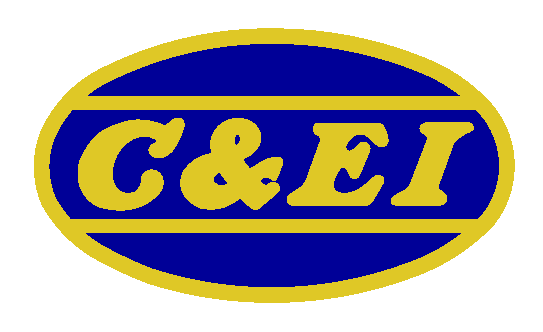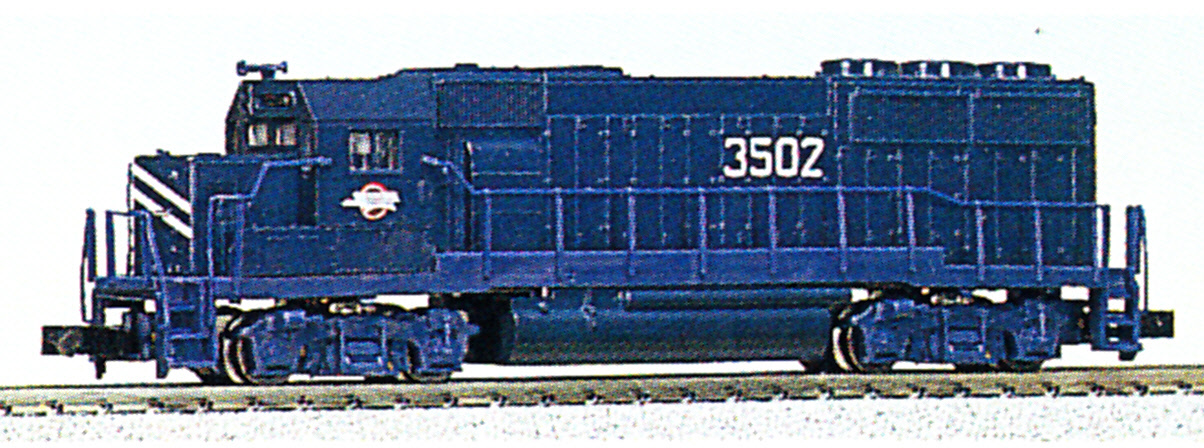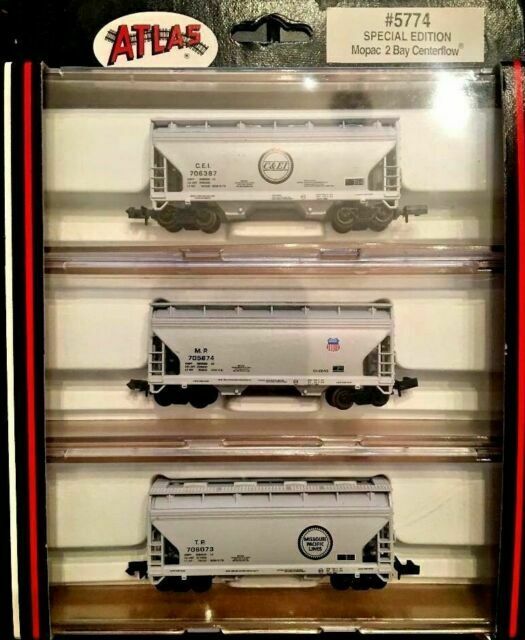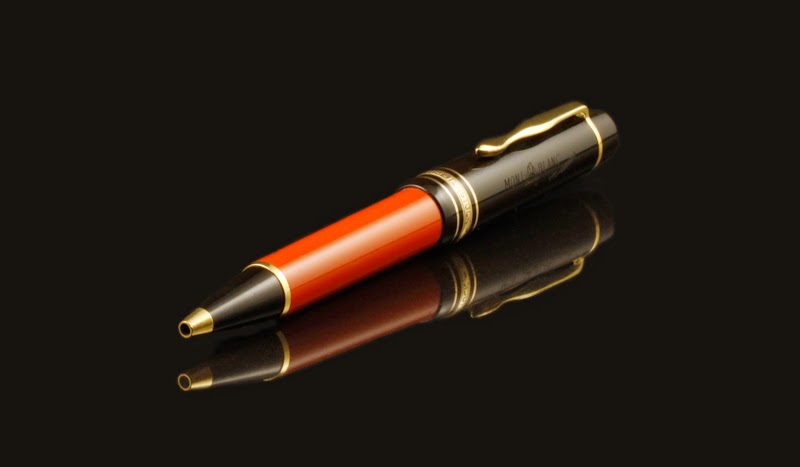Model Information: Introduced in September of 1983 with ATSF 151900 and 151951, Micro-Trains has produced 83 different versions of this car (as of March, 2016). Body style 027 represents a 50 foot prototype "Plug" single-door Box Car. Unlike the "Sliding" door, the plug door system closes with a final inward movement (similar to most van sliding doors) that seals the door flush with the interior of the boxcar. This provides a much better seal than the sliding door boxcar. A rotating lever on the door activates a gear system to "plug" and "unplug" the door.
Unfortunately for collectors, this means that in order to accurately portray the prototype, this body style does not feature doors that actually open. All other hallmark features of Micro-Trains quality are present. This includes high quality tooling, crisp printing and the ubiquitous knuckle coupler.
Unfortunately for collectors, this means that in order to accurately portray the prototype, this body style does not feature doors that actually open. All other hallmark features of Micro-Trains quality are present. This includes high quality tooling, crisp printing and the ubiquitous knuckle coupler.
Prototype History: While the 40-foot boxcar was a standard design, and it did come in different setups depending on the type of freight being transported, it was not large enough for efficient mass commodity transportation. The 50-foot boxcar made its first appearance in the 1930s and steadily grew in popularity over the years, which further improved redundancies by allowing for even more space within a given car. Today, the 50-footer remains the common boxcar size. After the second world war ended, and steel became once again readily available, steel became the go-to choice for construction of boxcars. Pullman Standard and ACF were some of the most prolific builders of these cars.
These cars came in many variations. For instance, double-doors became practical for large/wide loads, end-doors useful for very large lading such as automobiles, and interior tie-down equipment was helpful in keeping sensitive products from being damaged in-transit. In 1954 the Santa Fe developed its "Shock Control" (and later "Super Shock Control") technology for new boxcars with upgraded suspension systems to further improve the ride-quality and reduce the chance of damaging freight.
In the 1960s, the flush, "plug" style sliding door was introduced as an option that provides a larger door to ease loading and unloading of certain commodities. The tight-fitting doors are better insulated and allow a car's interior to be maintained at a more even temperature.
These cars came in many variations. For instance, double-doors became practical for large/wide loads, end-doors useful for very large lading such as automobiles, and interior tie-down equipment was helpful in keeping sensitive products from being damaged in-transit. In 1954 the Santa Fe developed its "Shock Control" (and later "Super Shock Control") technology for new boxcars with upgraded suspension systems to further improve the ride-quality and reduce the chance of damaging freight.
In the 1960s, the flush, "plug" style sliding door was introduced as an option that provides a larger door to ease loading and unloading of certain commodities. The tight-fitting doors are better insulated and allow a car's interior to be maintained at a more even temperature.
Road Name History:  The Chicago & Eastern Illinois was formed in 1877 as a result of the reorganization of the Chicago Danville & Vincennes. By 1902 the C&EI ran south out of Chicago and split into three routes south of Danville, Illinois.
The Chicago & Eastern Illinois was formed in 1877 as a result of the reorganization of the Chicago Danville & Vincennes. By 1902 the C&EI ran south out of Chicago and split into three routes south of Danville, Illinois.
The eastern fork followed the Indiana-Illinois border (on the Indiana side) south to Evansville near the Kentucky border. At Evansville, traffic was primarily handed off to Louisville & Nashville for points in the South. This route saw the lion’s share of C&EI’s passenger business. In fact, many Chicago to Florida passenger limiteds traveled the C&EI from Chicago to Evansville. The Dixie Flagler, for instance, was routed: C&EI, Louisville & Nashville, Nashville Chattanooga & St. Louis, Atlanta Birmingham & Coast, Atlantic Coast Line, and Florida East Coast to get to Miami.
The center fork passed through Salem and Mount Vernon to the southern tip of Illinois, over the Thebes Bridge to Chaffee, Missouri and friendly connections with Cotton Belt, Frisco, and MoPac. This line generated considerable coal traffic in addition to through freight from Chicago to Louisiana and East Texas. Passenger service was provided by The Meadowlark. In later years this train used ACF Motorailers and later still, Budd RDC’s.
The western fork went to St. Louis. However the line from Pana, Illinois to St. Louis was actually on trackage rights with New York Central’s “Big Four” route. Passenger service on this line ended right after WWII due to unbeatable competition from GM&O, IC, and Wabash.
Total system mileage maxed out at about 950, putting C&EI between Lackawanna and Montana Rail Link in relative size. Prior to 1933, C&EI had been controlled by Frisco, then Chesapeake & Ohio (on behalf of the Van Sweringen Brothers.) That year brought another receivership but freed them from control by other lines for more than three decades.
In the 1960s, Louisville & Nashville, Illinois Central and Missouri Pacific dueled for control of the C&EI. In 1967, a compromise was reached. MoPac took control of the C&EI and sold the Evansville line and half interest in the line from Danville to Chicago to the L&N. L&N also received portions of the C&EI diesel and freight car fleets and most of the remaining passenger equipment. The sales to L&N were completed in 1969.
The remaining C&EI diesels were painted MoPac “Jenks Blue” and received buzzsaw logos with “C&EI” within. In 1976, the C&EI was merged into the Missouri Pacific.

The eastern fork followed the Indiana-Illinois border (on the Indiana side) south to Evansville near the Kentucky border. At Evansville, traffic was primarily handed off to Louisville & Nashville for points in the South. This route saw the lion’s share of C&EI’s passenger business. In fact, many Chicago to Florida passenger limiteds traveled the C&EI from Chicago to Evansville. The Dixie Flagler, for instance, was routed: C&EI, Louisville & Nashville, Nashville Chattanooga & St. Louis, Atlanta Birmingham & Coast, Atlantic Coast Line, and Florida East Coast to get to Miami.
The center fork passed through Salem and Mount Vernon to the southern tip of Illinois, over the Thebes Bridge to Chaffee, Missouri and friendly connections with Cotton Belt, Frisco, and MoPac. This line generated considerable coal traffic in addition to through freight from Chicago to Louisiana and East Texas. Passenger service was provided by The Meadowlark. In later years this train used ACF Motorailers and later still, Budd RDC’s.
The western fork went to St. Louis. However the line from Pana, Illinois to St. Louis was actually on trackage rights with New York Central’s “Big Four” route. Passenger service on this line ended right after WWII due to unbeatable competition from GM&O, IC, and Wabash.
Total system mileage maxed out at about 950, putting C&EI between Lackawanna and Montana Rail Link in relative size. Prior to 1933, C&EI had been controlled by Frisco, then Chesapeake & Ohio (on behalf of the Van Sweringen Brothers.) That year brought another receivership but freed them from control by other lines for more than three decades.
In the 1960s, Louisville & Nashville, Illinois Central and Missouri Pacific dueled for control of the C&EI. In 1967, a compromise was reached. MoPac took control of the C&EI and sold the Evansville line and half interest in the line from Danville to Chicago to the L&N. L&N also received portions of the C&EI diesel and freight car fleets and most of the remaining passenger equipment. The sales to L&N were completed in 1969.
The remaining C&EI diesels were painted MoPac “Jenks Blue” and received buzzsaw logos with “C&EI” within. In 1976, the C&EI was merged into the Missouri Pacific.
Brand/Importer Information: Micro-Trains is the brand name used by both Kadee Quality Products and Micro-Trains Line. For a history of the relationship between the brand and the two companies, please consult our Micro-Trains Collector's Guide.
Manufacturer Information:  Kadee Quality Products originally got involved in N-Scale by producing a scaled-down version of their successful HO Magne-Matic knuckle coupler system. This coupler was superior to the ubiquitous 'Rapido' style coupler due to two primary factors: superior realistic appearance and the ability to automatically uncouple when stopped over a magnet embedded in a section of track. The success of these couplers in N-Scale quickly translated to the production of trucks, wheels and in 1972 a release of ready-to-run box cars.
Kadee Quality Products originally got involved in N-Scale by producing a scaled-down version of their successful HO Magne-Matic knuckle coupler system. This coupler was superior to the ubiquitous 'Rapido' style coupler due to two primary factors: superior realistic appearance and the ability to automatically uncouple when stopped over a magnet embedded in a section of track. The success of these couplers in N-Scale quickly translated to the production of trucks, wheels and in 1972 a release of ready-to-run box cars.
In October 1990 Kadee separated in two companies, with the newly created Micro-Trains® Line Co. continuing the Z, Nn3, and N Scale product ranges, with Kadee retaining the HO range.

In October 1990 Kadee separated in two companies, with the newly created Micro-Trains® Line Co. continuing the Z, Nn3, and N Scale product ranges, with Kadee retaining the HO range.
Item created by: nscalemodeler160 on 2016-04-07 15:05:49. Last edited by CNW400 on 2020-09-24 14:17:42
If you see errors or missing data in this entry, please feel free to log in and edit it. Anyone with a Gmail account can log in instantly.
If you see errors or missing data in this entry, please feel free to log in and edit it. Anyone with a Gmail account can log in instantly.








